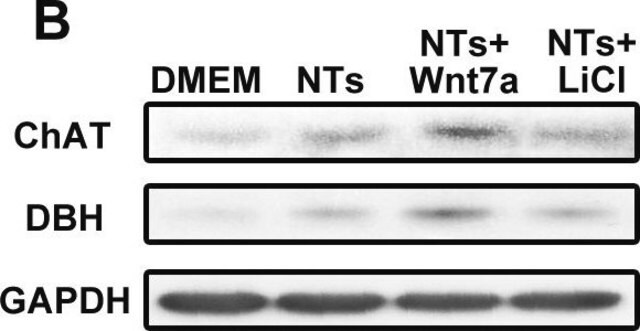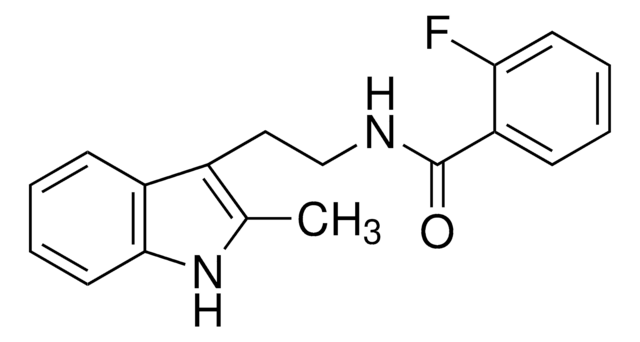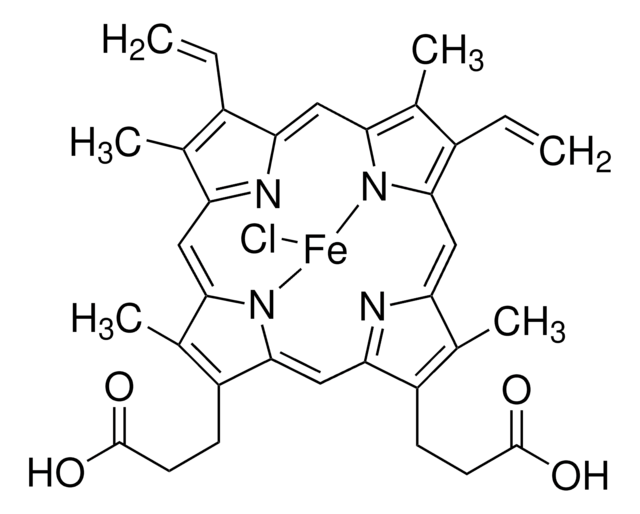推荐产品
品質等級
化驗
≥98% (HPLC)
形狀
powder
儲存條件
desiccated
顏色
white to tan
溶解度
DMSO: ≥25 mg/mL
起源
Bayer
儲存溫度
2-8°C
SMILES 字串
Fc1ccc(cc1)CN2C[C@H](N(CC2)C(=O)COc3c(cc(cc3)Cl)NC(=O)N)C
InChI
1S/C21H24ClFN4O3/c1-14-11-26(12-15-2-5-17(23)6-3-15)8-9-27(14)20(28)13-30-19-7-4-16(22)10-18(19)25-21(24)29/h2-7,10,14H,8-9,11-13H2,1H3,(H3,24,25,29)/t14-/m1/s1
InChI 密鑰
XQYASZNUFDVMFH-CQSZACIVSA-N
應用
BX471 has been used in chemotaxis assay to study the responses of HEK293 cells expressing human C-C motif chemokine receptor 1 (CCR1) to CC motif ligand 3 (CCL3)-induced cell migration. It has also been used as a CCR1 inhibitor to assess the effects of CCR1 on the migration and epithelial-mesenchymal transition (EMT).
生化/生理作用
BX471 blocks CCR1 and downregulates the mRNA expression of ICAM-1, P-selectin and E-selectin. It decreases the inflammatory responses in sepsis, prevents monocyte recruitment in inflammation sites in rheumatoid arthritis patients and inhibits interstitial leukocyte recruitment and fibrosis in mouse model of lupus nephritis.
BX471 is an orally active, CCR-1 specific antagonist. It displaces the endogenous CCR-1 ligands MIP-1a, RANTES and MCP-3 (Ki range 1-5 nM). BX471 inhibits CCR-1 effects in leukocytes, including calcium mobilization and migration.
特點和優勢
This compound is featured on the Chemokine Receptors page of the Handbook of Receptor Classification and Signal Transduction. To browse other handbook pages, click here.
This compound was developed by Bayer. To browse the list of other pharma-developed compounds and Approved Drugs/Drug Candidates, click here.
儲存類別代碼
11 - Combustible Solids
水污染物質分類(WGK)
WGK 3
閃點(°F)
Not applicable
閃點(°C)
Not applicable
Human MSCs promotes colorectal cancer epithelial-mesenchymal transition and progression via CCL5beta-catenin Slug pathway
Chen K, et al.
Cell Death & Disease, 8(5), e2819-e2819 (2017)
Maria C Lebre et al.
PloS one, 6(7), e21772-e21772 (2011-07-13)
The aim of this study was to provide more insight into the question as to why blockade of CCR1, CCR2, and CCR5 may have failed in clinical trials in rheumatoid arthritis (RA) patients, using an in vitro monocyte migration system
The role of CCR1 and therapeutic effects of anti-CCL3 antibody in herpes simplex virus-induced Behccet's disease mouse model
Sayeed HM, et al.
Immunology (2019)
Hans-Joachim Anders et al.
Journal of the American Society of Nephrology : JASN, 15(6), 1504-1513 (2004-05-22)
Slowly progressive renal injury is the major cause for ESRD. The model of progressive immune complex glomerulonephritis in autoimmune MRL(lpr/lpr) mice was used to evaluate whether chemokine receptor CCR1 blockade late in the disease course can affect progression to renal
Nagarajan Vaidehi et al.
The Journal of biological chemistry, 281(37), 27613-27620 (2006-07-14)
A major challenge in the application of structure-based drug design methods to proteins belonging to the superfamily of G protein-coupled receptors (GPCRs) is the paucity of structural information (1). The 19 chemokine receptors, belonging to the Class A family of
商品
Sigma-Aldrich offers many products related to chemokine receptors for your research needs.
我们的科学家团队拥有各种研究领域经验,包括生命科学、材料科学、化学合成、色谱、分析及许多其他领域.
联系技术服务部门






